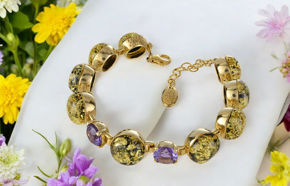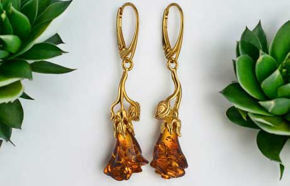When purchasing amber, it is important to know whether you’re receiving genuine Baltic amber—or a cheap imitation. With scientific advances in creating gemstones and other materials dating back to the 18th century, the Baltic amber jewelry market has been flooded with copies of inferior quality that are seeking to fool the average consumer. Therefore, knowing if you’re paying for the genuine natural Baltic amber jewelry ensures not only that you’re getting value, but also ensuring that the natural healing power of ambers is intact. In this article, we’ll take a look at the most common forms fake amber types and methods on how to determine the authenticity of genuine amber.
The Types of Fake Amber
There is a common misunderstanding among novice jewelry buyers to assume that amber is an actual gemstone. While it is typically classified as healing crystals and gemstones, it is actually a fossilized resin. And therein lies how counterfeiters take advantage of consumers.
The following materials are commonly used in the production of fake Baltic amber:
Casein
Celluloid
Copal
Glass
Modern plastics
Phenolic resins
Casein
Casein is a plastic material that’s made from mammalian milk (i.e goats, cows ). Commonly shaped as beads, they have a murky, opaque yellow color that is slightly heavier than Baltic amber. Once heated, it diffuses the smell of burnt plastic, which is a telltale sign of counterfeit amber.
Celluloid
Composed of cellulose nitrate and camphor, celluloid is a trademarked thermoplastic that is often yellow and cloudy. One option to know if Baltic amber is genuine and not celluloid is to rub it.If rubbed the celluloid imitation does not become as electrostatically charged. Additionally, when heated, celluloid amber gives off the unmistakable odor of camphor or burnt plastic.
Copal
Copal is a form of amber that is close to genuine Baltic amber. However, copal comes from tree resins that can be anywhere 1000 – 1 million years old—genuine amber is actually 30 – 90 million years old. While natural inclusions (plant or animal material) are possible in copal, they are more often than not falsified. One way to determine if it is copal is whether the insects contained in the “amber” are in better too good of a condition. Another way to determine if your Baltic amber is actually copal is whether it melts at a low temperature (lower than 150 Celsius/302 Fahrenheit ); genuine amber tends to burn rather than melt. When heated it diffuses the sweet smell of burning resins.
Glass
Glass is a versatile material, but it is relatively easy to distinguish glass from genuine Baltic amber. Glass is more solid, more resistant to extreme temperatures, and cannot be scratched easily by metal.
Modern plastics
Including polystyrene and polyester, there are a number of modern plastics that are being developed to aid amber counterfeiters, especially for creating amber jewelry with inclusions. Optically, modern plastic “amber” is difficult to distinguish from real Baltic amber because of their matched amber colors and limpidity (translucence). As with copal, inclusions are often too big and are too clearly seen. Once heated, plastics typically diffuse the smell of burnt plastic, not Baltic amber’s pine smell.
Phenolic Resin
Phenolic resin is a versatile substance used for a number of industrial and commercial purposes, due to its inherent properties of strength and flexibility. This is why this material is commonly found in artificial Baltic amber beads, especially since the color is remarkably similar to real amber (limpid, murky yellow, and deep red). Amber beads made from the phenolic resin can be distinguished by a “too exact” exact shape (oval, faceted) and a smell that doesn’t diffuse the characteristic pine smell of genuine Baltic amber.
Tests to Determine Genuine Baltic Amber
There are a number of tests to determine fake from natural Baltic amber:
Buoyancy Test
When dropped into seawater, Baltic amber will float or be buoyant. This is the reason why it washes up on the beaches of the Baltic Sea after a turbulent storm. By using salt-saturated water similar to seawater (~2.5 tablespoons of salt per 1 cup of water), amber imitations of amber will sink in salt water.
Solvent test
Baltic amber is resistant to solvents, which means that it won’t feel sticky or dissolve under. However, copal and plastic amber will deteriorate when in contact with a solvent, like an ethyl alcohol, acetone, or ether. Using a few drops of acetone (otherwise known as nail polish remover) over the surface of the piece reveals whether the amber holds up to the solvent. If the surface becomes tacky, then you can rest assured that it's not genuine Baltic amber.
Heat test
When Baltic amber is heated, it produces a whitish smoke and gives off a smell like burning pine wood, which is sweet and pleasant. One heat test is to use a heated needle in an unobtrusive place on the amber. If the smell is plastic, it gives off a smell of camphor (celluloid), carbolic acid, or any other “plastic” smell. Additionally, the hot point will make the plastic sticky and malleable, while also leaving a black mark. If amber is genuine, this test will make the amber brittle and it also can chip off. Therefore, it’s more often is a good choice to leave this to a trained professional that won’t mar precious jewelry.
Static test
Of all of the tests, the static test is the simplest and safest test to perform on your amber. Baltic amber is warm to the touch and when rubbed, it will become electrostatically charged and attract small particles, like dust or paper.












